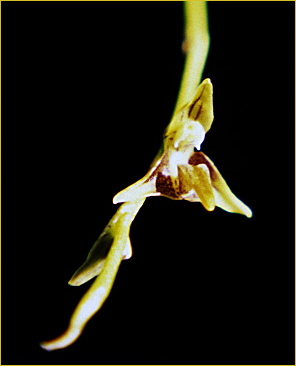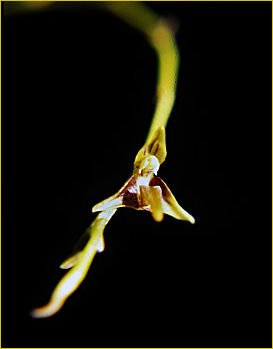
 |
Claudio
Nicoletti de Fraga Instituto de Pesquisas Jardim Botânico do Rio de Janeiro, Programa Zona Costeira/ Curadoria de Coleções Vivas, Rua Jardim Botânico 1008, 22470-051, Jardim Botânico, Rio de Janeiro-RJ, Brazil. cnfraga@jbrj.gov.br |
 |
ABSTRACT. Bulbophyllum boudetiana Fraga (Orchidaceae),
a new species from Espírito Santo that grows in saxicolous vegetation
mats on an inselberg in the Brazilian Atlantic forest, is described, illustrated,
and compared with related species. This new species is related to Bulbophyllum
kautskyi, from which it differs by yellow flowers with cream spots,
abbreviated rhizomes, aggregate and ovoid pseudobulbs, petals scale-shaped,
labellum thick- fleshy, and disc slightly sulcate and ciliate on the base. Key words: Atlantic forest, Brazil, Bulbophyllum, Espírito Santo, Orchidaceae. The eastern Brazilian Atlantic coastal forest extends for more than 3000 km as an almost continuous band formed by a chain of mountain ranges that parallel the Atlantic Ocean, isolated by vast stretches of cerrado and caatinga from the moist forest of the Amazon basin and characterized by a high percentage of plant endemism (Mori et al., 1981). The high species richness of the vegetation mats and of most other plant communities on eastern Brazilian inselbergs is exceptional when compared to other tropical areas. Rock outcrops usually do not attract much agricultural interest: they have frequently been preserved from human impact and have kept their refugial character (Porembski et al., 1998). As a result of fieldwork at various inselbergs in Espírito Santo, I have found a new orchid species on the Pedra Branca (white rock) inselberg that is described and illustrated in this paper. Currently 1100 species are recognized in Bulbophyllum Thouars, which has a pantropical distribution (Dressler, 1993). The last revision of this genus for Brazil was that of Cogniaux (1902), in which 42 species were recorded; according to Pabst and Dungs (1975, 1977) this number was raised to 54. Since then, 3 species have been described in recent publications of Borba et al. (1998), Fraga (1999), and Brito (2000), making a total of 57 species. Bulbophyllum boudetiana Fraga, Novon 14: 40-42. 2004. TYPE: Brazil. Espírito Santo: Serra, Pedra Branca, elev. 300 m, 11 July 2000 (fl), C. N. Fraga 636 (holotype, MBML; isotype, RB). Figure 1. Haec species Bulbophyllo kautsky similis, sed pseudobulbis aggregatis et ovoideis, petalis squamiformibus, labello crasse carnoso et ciliato cum marginibus non revolutis differt. Plants epiphytic, creeping, up to 4 cm tall. Roots many, 0.5 mm diam., fasciculate, terete, glabrous, emerging near the margins with the pseudobulb. Rhizomes ca. 2 mm diam., abbreviated, internodes 2–3 mm long. Pseudobulbs 6–8 x 5–8 mm, aggregate, erect, ovoid, each 4-angled, monophyllous, yellow. Leaves 18–32 x 6–8 mm, sessile, oblong to elliptic-oblong, erect-patent, coriaceous, obtuseattenuate at base, apex acute-apiculate, green. Inflorescence emerging from below pseudobulb, up to 25 cm long, spicate, usually pendulous, producing 10 to 15 flowers, green to yellow; peduncle 11–13 cm long, terete, elongate, with small, appressed, tubular, widely spaced, 4 to 5 pale sterile bracts; rachis 10–12 cm long, straight to flexuous, sub-terete; floral bracts 3–4 3 1–2 mm, ovate-triangular, amplexicaul, acute-acuminate, usually spreading, yellow or green when young and paleaceous at anthesis. Flowers opening in succession, occasionally 2 flowers at anthesis simultaneously, yellow with brown cream spots; ovary with pedicel up to 1.5 mm, slightly obconical, sulcate, somewhat twisted and curved, cream; dorsal sepal 3.5–4.5 x 2–3 mm, ovate-lanceolate, glabrous, concave, acuminate, 3-veined, yellowish with nut-brown spots; lateral sepals 5–6.5 x 2.5–3.5 mm across the basal portion, free, glabrous, triangular-ovate, distinctly acuminate, oblique, deflexed, 3-veined, yellow toward apex with cream points toward base; petals small, 0.4–0.6 x 1.5–2 mm, covered with scales, glabrous, appressed to column, yellow toward apex and translucent toward base; labellum 4.5–5.5 x 2–3 mm, up to 2 mm wide when spread, articulate with the column foot, thick-fleshy, ovate-ligulate from above, disc slightly sulcate and ciliate at the base, geniculate in side view, abaxially provided |
|
with an amorphous callosity or keel, base geniculate, apex acute; column
1–1.5 x 0.5–0.7 mm, thick, provided with two rudimentary arms
at apex and two small falcate teeth on the abaxial margins or less in
the middle, prolonged into 3.5–4 mm long, curved foot, white with
nut-brown spots on the abaxial face; anther 1 x 1 mm, apical, versatile,
papillose, two pairs of pollinia, white. Etymology. The name of the new species pays homage to Helio de Queiroz Boudet Fernandes, director of the Mello Leita˜o Biological Museum and Herbarium MBML curator in Santa Teresa, Espírito Santo. In the field, Bulbophyllum boudetiana is recognized by its yellow flowers with cream spots, abbreviated rhizomes, 2–3 mm between the aggregate and ovoid pseudobulbs, petals covered with scales, labellum thick-fleshy, and disc slightly sulcate and ciliate at the base and with non-revolute margins; Bulbophyllum kautskyi Toscano has dark purple flowers, with usually green spots and yellow base, woody rhizomes with several articulations, 15–20 mm between the conical to narrowly ovoid pseudobulbs, petals acute, labellum fleshy, and disc slightly sulcate and glabrous and with revolute margins. The new species is known only from the type locality but may be expected in adjacent saxicolous vegetation mats on inselbergs in the Brazilian Atlantic forest in Espírito Santo. |
Acknowledgments.
I thank Michel Frey for the Latin diagnosis, and Helio de Queiroz Boudet
Fernandes for his assistance during fieldwork. I am also grateful to Antonio
Toscano de Brito for his comments and help with the literature. |
 |
| Literature
Cited -Borba, E. L., J. Semir & F. Barros. 1998. Bulbophyllum involutum Borba, Semir & F. Barros (Orchidaceae), a new species from the Brazilian ‘‘campos rupestres.’’ Novon 8: 225–229. -Brito, A. L. V. T. 2000. Two new species of Orchidaceae from Brazil. Lindleyana 15(3): 184–188. -Cogniaux, A. 1902. Orchidaceae. Pp. 1–664 in C. F. P. Martius, A. G. Eichler & I. Urban (editors), Flora Brasiliensis . . . , vol. 3, part 5. München, Wien, Leipzig. -Dressler, R. L. 1993. Phylogeny and Classification of the Orchid Family. Cambridge Univ. Press, Cambridge. -Fraga, C. N. 1999. Bulbophyllum gomesii Fraga (Orchidaceae), uma nova espécie da floresta atlântica do Espírito Santo, Brasil. Bradea 8(24): 135–138. -Mori, S. A., B. M. Boom & G. T. Prance. 1981. Distribution patterns and conservation of eastern Brazilian coastal forest tree species. Brittonia 33: 357–370. -Pabst, G. F. J. & F. Dungs. 1975. Orchidaceae Brasiliensis, Vol. I. Kurt Schmersow, Hildesheim. ---- &---- . 1977. Orchidaceae Brasiliensis, Vol. II. Kurt Schmersow, Hildesheim. -Porembski, S., G. Martinelli, R. Ohlemuller & W. Barthlott. 1998. Diversity and ecology of saxicolous vegetation mats on the inselbergs in the Brazilian Atlantic rainforest. Diversity and Distributions 4: 107–119. Photos: Claudio Nicoletti |
| Any
kind of reproduction (print, digital or anyone) of any type of material
of this site: texts, layout, photos, images and others - is strictly
forbidden without previous written permission of the authors. Any solicitation
or information should be done by the e-mail: bo@sergioaraujo.com |